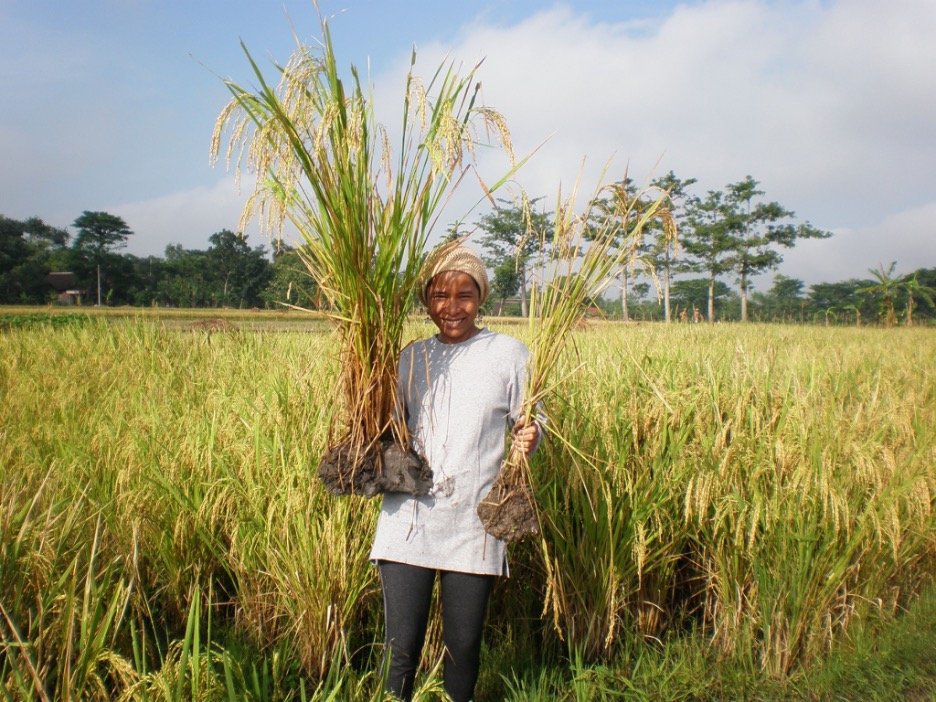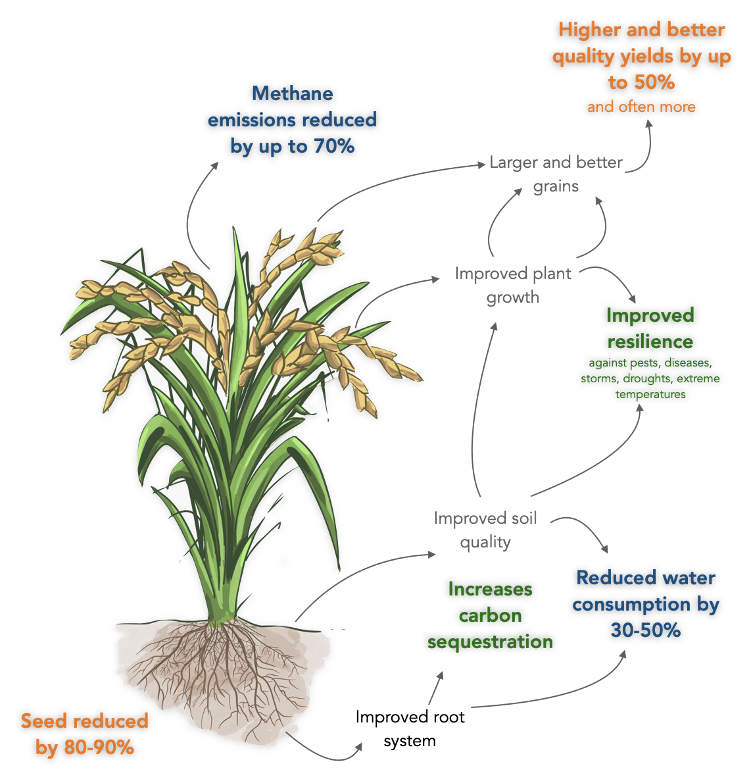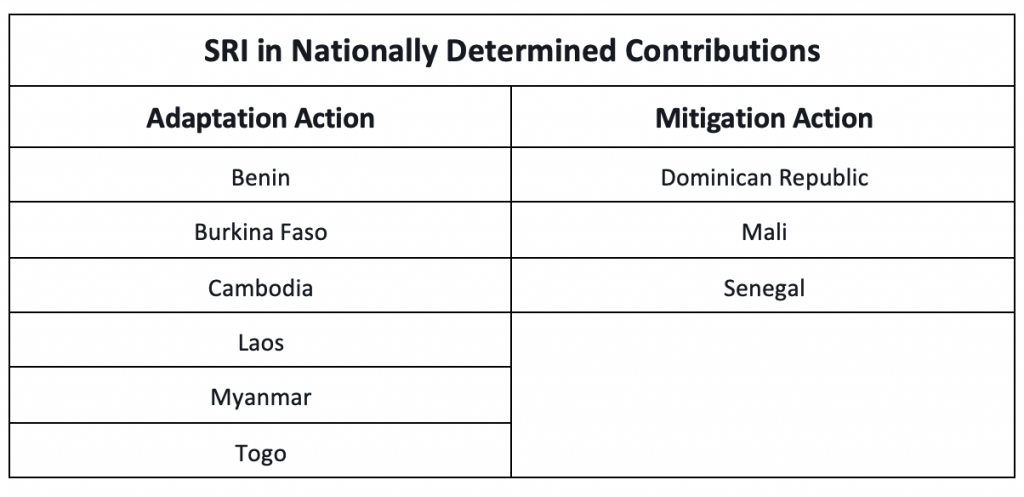By Jen McCallum, SRI-2030
Rice is a significant crop for the world. Rice plays a critical role in food security being the staple crop for over half the world’s population. It is central to the daily activities of many, with over 1 billion people relying on it for their livelihoods. It is also used for ceremonial purposes, medicinal and religious uses. The majority of rice producers worldwide are small-holder farmers, living on the front-line of climate change, trying to secure steady food and income.
However, traditional rice cultivation severely impacts the natural environment. Covering around 167 million hectares globally, rice is an incredibly thirsty crop using on average 34-43% of the world’s irrigation water, with around 2,500 litres of water needed to produce 1 kilogram of rice. Due to continually flooding paddy fields, rice emits around 10% of global methane emissions making it the second biggest producer of methane in agriculture. Rice farmers’ dependence on agrochemicals such as fertilisers, pesticides and herbicides adds to the adverse intensive land-use, depleting agricultural soils polluting the surrounding environments and further undermining resilience.
With the world’s population estimated to reach 9.6 billion by 2050, food and agricultural land demands are only set to increase. But without radical change to the way we farm, our food security, climate impacts, and social development will regress. Agricultural systems are fundamental to the survival and prosperity of every nation, but adaptation is necessary to transition to ecologically resilient methods that support sufficient productivity.

SRI: A triple-win
Fortunately, the System of Rice Intensification (SRI) provides a solution for a more resilient rice cultivation system to address these challenges.
SRI is an agroecological method of rice cultivation that, paradoxically, produces more from less. With SRI methods, farmers use already available resources more efficiently to produce larger yields per hectare with reduced inputs such as water, seed, energy, and agrochemicals, all while reducing the pressure to expand land for cultivation. SRI mitigates greenhouse gas emissions by creating aerobic soil conditions; and through cultivating an improved environment for growth, SRI seedlings develop into healthier and more robust plants, meaning the resulting crop is more resilient against pests, diseases, and extreme weather events. As external inputs are not required, SRI is an accessible innovation that even the most poor and marginalised households can use to improve their economic situation. SRI is a triple win for the planet, people and prosperity.
How does SRI work?
SRI follows four key principles that support the best conditions for plant growth:
- Start with young, healthy plants
- Optimise spacing to minimise competition between plants
- Build up healthy and fertile soil
- Apply only the minimum amount of water needed
Focusing on each plant’s health from the start of cultivation establishes the best foundation for growth. Plant density is reduced with greater spacing between each plant which provides better access to sunshine, water, and soil nutrients catalysing larger and deeper root systems and further enhancing crop growth. The deeper root systems are more efficient at accessing water and also anchor the plants more effectively meaning they can withstand extreme weather events such as droughts and storms. Organic matter improves the soil nutrients as well as enhancing its structure and functioning, making the soil more porous and better able to absorb rainwater, reducing water requirements and erosion. SRI evokes more robust and healthy crops that are better able to resist pests and diseases. This resistance is further bolstered by the increased spacing between the plants which creates less favourable microenvironments for many pests and diseases.
Water is provided intermittently, rather than flooding, also known as alternate wetting and drying (AWD). AWD keeps the soil in a mostly aerobic condition, meaning more oxygen reaches the roots, which promotes plant growth and sustains larger populations of beneficial soil organisms. AWD alone has been shown to mitigate methane emissions by anywhere between 30-70%, but it does not offer farmers the improved yield of SRI. SRI is an excellent proponent for supporting rice farmers’ improved food production with climate-resilience while mitigating environmental impacts.

SRI improves:
- Yields by at least 25-50%, with many examples up to and beyond 100%
- Food security, with larger and more nutritious yields
- Climate resilience of the rice plants, able to withstand pests and diseases, extreme temperatures, droughts, and storms better
- Women’s health, well-being, and status
- Soil health and biodiversity
- Farmer incomes
- Local and national economies
SRI reduces:
- Net GHG emissions by 50% per kilogram of rice including methane emissions by up to 70%
- Water consumption reduced by up to 50%
- Seed usage by between 80-90%
- Dependence on chemical fertilisers
- Land clearing requirements
SRI is a proven solution backed by over 30 years of substantial evidence and validated in over 60 countries by millions of farmers over an estimated 7 million hectares. Project Drawdown identified SRI as one of its top 50 climate solutions. Till now, SRI has mostly spread through farmer-to-farmer networks and grassroots movements, but with stronger institutional support SRI has the potential to be scaled much further and faster.
SRI-2030 has adopted Project Drawdown’s target of reaching 50 million hectares of SRI coverage by 2030. This will produce an extra 1 billion tonnes of rice, reduce emissions by 8.5 billion tonnes CO2e, and increase farmer profits by $1.6 trillion by 2050.
How to upscale SRI?
Nationally Determined Contributions (NDCs) are one way that countries can mobilise action. Nine countries currently include SRI as either a mitigation or adaptation action in their NDCs.

The majority of top rice-producing countries, however, do not include quantified rice mitigation measures and only 14% of countries that have signed the Methane Pledge have rice mitigation actions leaving a large opportunity for governments to capitalise on to meet net-zero targets.
Vietnam’s Government has set a positive example by committing to mitigate 6-32 million tons of CO2 equivalent in agricultural emissions by 2030. Rice accounts for over 50% of Vietnam’s national greenhouse gas emissions and they are supporting the transition of rice cultivation to more sustainable practices. SRI has been endorsed by the Ministry of Agriculture and Rural Development in Vietnam since 2007 and along with other local rice cultivation innovations that share similar principles to SRI. Vietnam is seizing the opportunity to contribute to both climate mitigation and adaptation while supporting more stable food production systems.
Appropriate policies to support SRI will depend on each country and local context. Examples include: financial incentives through schemes or subsidies; improved irrigation infrastructure; and supporting quality training through quality extension work. Adopting SRI is a matter of knowledge and skill rather than capital inputs and farmers should be supported to try out SRI and understand its methods. In Bihar, India, farmers were initially sceptical until one farmer in 2007 tried out SRI to great success. By 2012, Bihar had around 335,000 hectares of SRI coverage and the state now actively supports SRI expansion.
SRI presents an opportunity to support farmers to achieve resilience and improved food security against changing climates, while mitigating the negative impacts on the environment. SRI can achieve multiple sustainable development goals simultaneously and awaits thoughtful institutional action.
